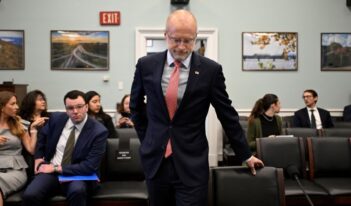
An FCC proposed rule for the national suicide and crisis hotline would route texters to local crisis centers.
Young Americans are disproportionately at risk for mental health crises. But when they seek help by texting the national mental health hotline, 988 Suicide & Crisis Lifeline, the system may direct them to the wrong counseling services or resources.
A recent Federal Communication Commission (FCC) proposed rule seeks to change that.
This proposed rule would require wireless providers to support a new routing system for the hotline’s text messaging function. Under the current system, text messages to 988 are routed to crisis centers based on the area code of the user’s phone number. The area code on a mobile phone, however, often does not match the user’s physical location.
Under the FCC’s proposed rule, users would be georouted to appropriate local crisis centers based on the geographic origins of their text messages. This proposed rule builds on an October 2024 FCC rule implementing georouting for voice calls. According to the FCC, this expansion to text messages would ensure “parity between texts and voice calls to 988.”
In its proposed rule, the FCC grapples with the benefits and costs of georouting 988 text messages.
As to the benefits, the FCC highlights that georouting 988 text messages would improve service and reduce suicide attempts. These effects would be pronounced among young users, who, according to the FCC, generate over 75 percent of 988 texts. The FCC reasons that georouting will improve service because local crisis centers are more familiar with local resources as well as issues in the user’s community.
The FCC also points out that state-wide routing would be insufficient. For example, large states such as New York and Texas have “vast economic, cultural, and language differences within their borders.” According to the FCC, local-level service could account for these intra-state differences.
As to the reasons against a change, the FCC acknowledges privacy concerns with the new approach. The FCC reasons, however, that the privacy of 988 users would be sufficiently protected.
Unlike the 911 system, which relies on the precise geo-location data to direct 911 calls to the appropriate location, the 988 georouting system would rely on more general information. For example, the FCC proposes using the Federal Information Processing Series system, which relies on unique two-digit state codes followed by three-digit county codes to identify geographic regions within the Unites States.
When it released its proposed rule late last year, the FCC sought public comments on its proposed approach, including on the benefits of georouting text messages, potential technical challenges and estimated costs of implementation, and the feasibility of the six-month deadline.
Most commenters—such as mental health organizations, local municipalities, and other advocacy groups—expressed strong support for the proposed rule.
According to Los Angeles County, the proposed georouting approach would address issues with the current system. For example, the county argues that misrouting 988 users to resources outside of the county damages current residents’ confidence in 988 and causes them to continue to rely on 911 and law enforcement.
The National Alliance on Mental Illness (NAMI)—the nation’s largest mental health network—strongly supported georouting text messages, but also encouraged transparency in the data collection process. According to NAMI research, 63 percent of people are more likely to contact 988 if they believe they will remain anonymous.
Comments from advocacy groups also added nuance by discussing how the proposed rule would impact specific demographics.
For example, a joint comment from multiple organizations representing disabled communities applauded georouting text messages for increasing accessibility for communities where texting is the preferred or necessary mode of communication. But the organizations also called for the FCC to consider adopting a georouting requirement for its video call feature to ensure that American Sign Language (ASL) users have access to local ASL-fluent providers.
The Trevor Project—the nation’s largest suicide prevention organization for LGBTQ+ youth—underscored that “competency with LGTBQ+ youth issues is the critical element necessary to effectively support LGBTQ+ young people in crisis.” According to the organization, 988’s specialized LGBTQ+ service should be prioritized over georouting information.
Other commenters—particularly wireless providers—raised concerns with the proposed rule.
The Competitive Carriers Association (CCA) urged the FAA to hold off on adopting the new text message system so providers could focus their efforts on georouting the call system first. The CCA also pointed out that the technology behind georouting text message data “remains in its infancy.”
The Rural Wireless Association (RWA) argued that the implementation costs of the proposed rule may disproportionately impact rural non-nationwide wireless providers. According to the RWA, the FCC should make georouting text messages optional for these small providers, or, if not, subsidize their efforts and extend their implementation deadline.
If finalized, the FCC’s proposed rule would build on a series of regulations addressing the 988 hotline.
In July 2020, the FCC first issued a rule to establish 988 as the nationwide hotline for people experiencing mental health crises. The rule responded to the spike in mental health challenges during the COVID-19 pandemic. In 2020, for instance, the United States saw one death by suicide every 11 minutes.
The hotline provides free, around-the-clock, and confidential support, including access to counseling, resources, and referrals. The hotline is part of a larger initiative encompassing a network of more than 200 crisis centers around the country.
In October 2020, the 988 number replaced a prior 10-digit number following the passage of the National Suicide Hotline Designation Act.
Since then, many experts agree that the 988 hotline has been a success.
According to a July 2024 report, the 988 number received 10.8 million calls, texts, and chats in its two years of operation. Between 2022 and 2023, contacts with the 988 hotline increased by 33 percent nationally.
Call and text volumes and answer rates, however, vary by state. Rhode Island has been celebrated as a success story, with 98 percent of contacts answered by a crisis center within the state.
But other states are struggling to keep up with demand. Although federal funding supported the initial launch of the 988 system, ongoing operational costs fall on state and local governments. Recently, 10 states have added call fees to help cover funding for the initiative.
Since launching 988, the FCC has also issued regulations creating specialized 988 services for Spanish speakers, LGBTQ+ individuals, and veterans. The FCC’s September 2023 regulation expanded 988 services to include direct video calls to increase accessibility for users fluent in ASL.
The FCC’s recent proposed rule aligns with other mental health initiatives that had been pursued during the Biden Administration, including investments in behavioral health centers, expansions in the size and diversity of the mental health workforce, and initiatives aimed to lower mental health care costs. Given its deregulatory focus, it is yet to be seen whether the Trump Administration will modify or reverse these mental health initiatives or whether the FCC will eventually finalize its proposed rule on georouting text messages to 988.
If you are confronting a mental health challenge, experiencing emotional distress, or feel you just need to talk to someone, you may dial “988” to reach the free hotline discussed in this article.



